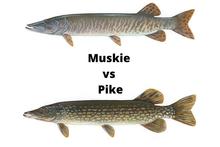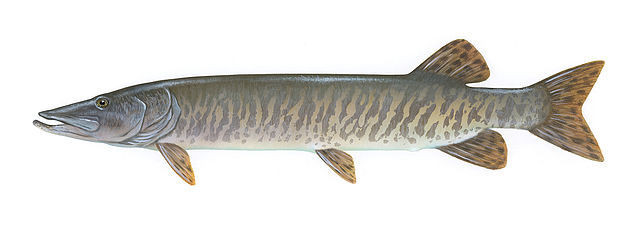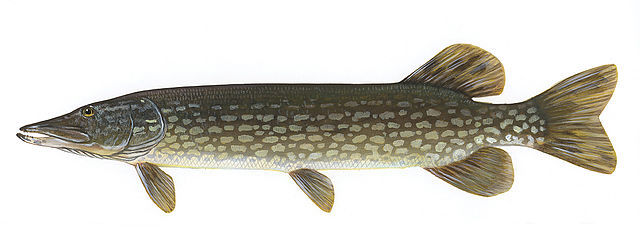This article may contain affiliate links. If you make a purchase after clicking on a link we may earn a small commission at no extra cost to you. As an Amazon Associate, I earn from qualifying purchases.
Muskie vs Pike – What’s the Difference?

There are few freshwater fish species outside of muskie and pike that are more sought after by anglers. These fish are also the two species that most often get confused for one another.
If you’re one of the many anglers who sometimes can’t tell the difference between a muskie and a pike, we’ve compiled this article to serve as a handy guide for doing so.
Muskie vs Pike
The best method to tell the difference between Muskie and Pike is to look at the tail. Both species have forked tails, however Muskie have a mush deeper v-split in the tail, whereas pike’s are more rounded.
In parts of the northern United States and Canada, muskie and pike are two of the most coveted species of fish that anglers target in the large lakes and river systems that stretch throughout upper North America.
They are both known for their long, powerful frames that allows them to swim with extraordinary speed and agility, which also makes them extremely challenging to land with a rod and reel.
Many beginner anglers mistakenly believe muskie and pike are the same species of fish, but that’s not the case. Though these two common freshwater predators have a lot of similarities, they also have distinct characteristics and behaviors that set them apart.
Pike have been given the nickname “water wolves” by anglers because they are known to hunt in packs and corral their prey before striking. They hunt schools of small bait fish with exceptional ferocity and have large mouths with very sharp teeth.
The muskie are also known to be a vicious predator willing to eat anything they can catch, but they are often referred to as the “fish of a ten thousand casts” due to the difficulty anglers have in catching them.
Muskie and pike are both part of the Esocidae family, which includes lots of pike and pickerel species that are native to North America. These two fish also belong to the same Esox genus within that species, but they do have some distinct differences between one another.
In the following sections, we’ll explain more about these two species in greater detail.
What is a Muskie?
The muskellunge, often known as the “fish of 10,000 casts,” is a species of big freshwater predatory fish endemic to North America. It is sometimes abbreviated to muskie, musky, or lunge. It is the biggest member of the Esocidae pike family.

There are a few different strains of muskie that exist throughout different parts of the United States and Canada. Some of these might have darker or lighter color combinations and markings, but they are essentially the same species.
Muskellunge are commonly found in large lakes and rivers throughout the upper Midwest and around the Great Lakes region in states like Michigan, Wisconsin and Minnesota.
Their range actually exceeds the borders of these states and anglers often find muskie as far south as Tennessee and north Georgia and eastward as far as New York and Maine.
In these states, they are often found in great numbers within lakes that have healthy, thriving ecosystems that offer a variety of different food sources. They are known to be ambush predators and have a very quick striking ability which they use to swiftly bite and even devour their prey with one lightning-quick attack.
There is virtually no other fish that muskie won’t eat—including their own kind. Muskies are known to prey upon a huge variety of different types of animals that are usually found around lakes and rivers such as rats, mice, frogs, ducks and insects.
Also Read: What do Musky Eat?
Usually found in areas of shallow water near the shore, although muskies might venture down into deeper waters during the summer or winter.
They are known to spawn during the spring and are considered to be among the most exciting freshwater fish that anglers can catch in North America.
What is a Northern Pike?
The northern pike is a carnivorous fish species in the genus Esox. They are found in brackish and fresh waterways across the Northern Hemisphere. In the United Kingdom, Ireland, and much of Eastern Europe, as well as Canada and the United States, they are simply known as pike.

Northern pike, which are commonly known as pike, have a body shape and profile that is very similar to that of a muskie. They have the same type of elongated body with overly-large mouths that are full of very sharp teeth that are used to bite and grasp larger prey than most freshwater fish will target.
It is this nearly identical body shape and fin structure that makes many anglers confused as to the identity of the fish they might have landed.
These fish tend to vary in their body color with some having a lighter coloration while others might be much more vibrant or darker. Pike are found throughout a much larger section of the North American continent, as well as in vast regions of Europe and Asia.
The Eurasian northern pike are often capable of growing to much larger sizes than the North American variety, but these fish are not what any angler would consider to be small, by any means.
Also Read: Pike vs Pickerel
Pike generally prefer to live in slow-moving water or shallow, weedy stretches of lakes and reservoirs where the water is mostly shallow. Their hunting style is that of an ambush predator as they will often remain very still in the water for long periods and strike with exceptional quickness, devouring their prey in one bite.
Also Read: What do Pike Eat?
They are mostly found in clear water and will spawn during the spring once water temperatures reach 40 degrees in most areas. Pike are very territorial fish and are known to be aggressive toward other pike that might encroach on their habitat.
How Big Do Muskie Get?
Muskie are known to be one of the larger fish in the waters where they are found. The average weight of a full-grown muskie is usually anywhere from 15 to about 35 pounds with anything exceeding this size being considered a trophy-sized fish.
Their length is also something that makes them stand out from other fish species and muskies often grow to be anywhere from 28 to 48 inches with the right diet and habitat.
The world record muskie is recognized as a whopping 69-pound, 11-ounce giant that was landed in 1949 in northern Wisconsin.
How Big Do Pike Get?
The average size for a northern pike is slightly smaller than that of a muskie. Pike often grow to a weight of around 5 to 7 pounds in most conditions and they typically measure 24 to 32 inches in length. However, they are capable of growing to much larger sizes with optimal growing conditions and diet.
The IGFA world record northern pike was caught in Europe, but the largest pike ever landed in North America is recorded as a giant that weighed 46-pounds, 2-ounces and measured 52.5 inches in length. The fish was caught in 1940 in New York’s Great Sacandaga Lake.
Differences between Pike and Musky
1. Color Pattern or Markings
One of the major differences between a muskie and pike are the color markings along their bodies. The muskie typically has different color patterns and will usually be lighter in color than a pike. What is more distinct is the dark black spots or bars that are found on the sides of the muskie, which sometimes appear to be stripes in some cases.
A pike will always have a more dark complexion than a muskie and their overall tone is more olive-colored and distinct. Along with this dark-green coloring will be small bean-shaped spots that are light in color all over the pike’s body.
One of the easiest ways for anglers to tell the difference between muskie vs pike is to observe whether the fish has dark black vertically-aligned bars, or these light-colored spots.
Another point related to their coloration and markings is that the pike’s color pattern and spots will run the length of its body, including the head. The muskie, on the other hand, has markings and bars that run only up to about the gill covers.
2. Tail Shape
One of the other ways you can tell pike vs muskie apart is to observe the shape of the tail. This is often the most reliable way for some anglers to tell what type of fish they have caught.
Both a muskie and a pike will have a tail that’s relatively the same size in proportion to the fish’s body, but there is one slight difference between a muskie vs pike.
A muskie will have a much more pointed tail that also has a slightly deeper V-shaped fork. The tail of the muskie is also known to have black spots on it while the tail of a pike is slightly yellow with dark green mixed in.
The northern pike’s tail is much more rounded than that of the muskie and it will feature a lesser V-shaped fork in its tail as well.
3. Number of Pores
The last method you can use to tell the difference between a muskie vs pike is to look at the fish’s lower jaw. Each type of fish will have holes or pores on the underside of its jaw, but the number of pores is different on a muskie vs pike.
Pike typically have about 4 or 5 of these pores underneath the jaw while a muskie will have at least 7 pores on either side of its lower jaw.
Conclusion
It’s easy to see why anglers love to catch both muskie and pike as they are able to grow to large sizes and put up an immense fight when hooked. Using these identification methods, you should be able to confidently tell what type of fish you’ve caught when fishing for muskie or pike.
